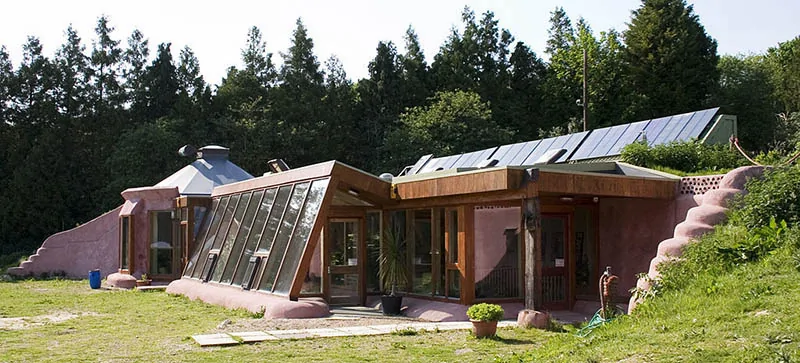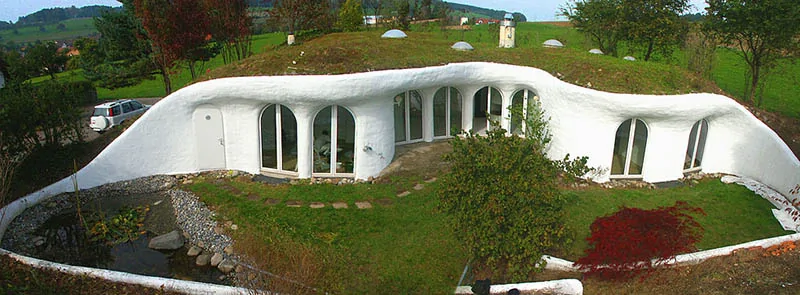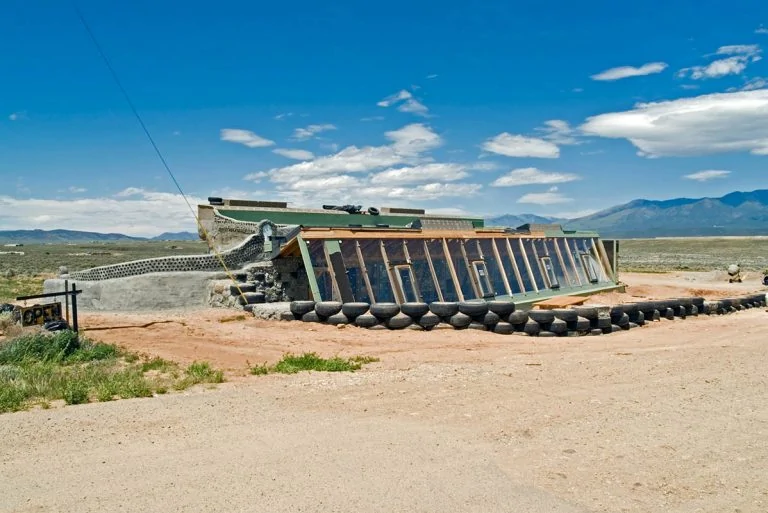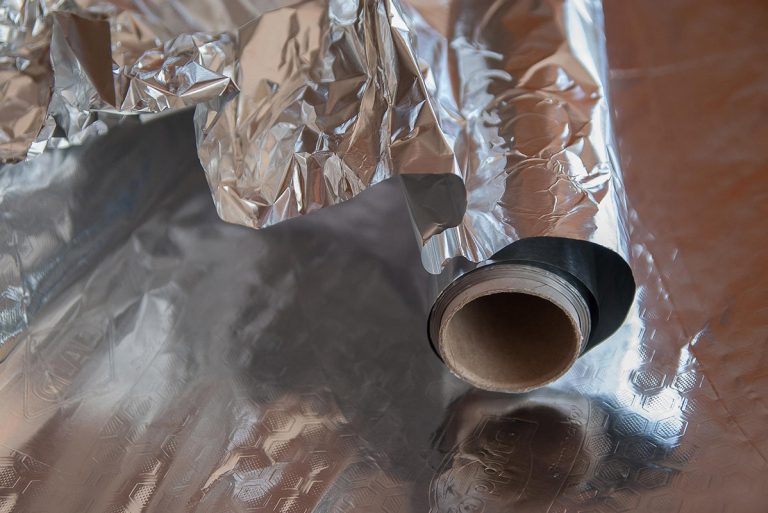If living at one with nature, taking energy from the earth, and growing your own food sounds like a dream, think again! Earthship homes are designed to turn this eco-friendly dream into a reality.
What are Earthship homes?
Earthship homes aren’t new – they were first built in the 1970’s. They have grown in popularity since then, based around the core concept of living as sustainably and as close to nature as possible.
One of the key characteristics of these homes is that they take advantage of passive solar energy and thermal dynamics. They are also made of a combination of natural and upcycled materials and incorporate renewable sources of electricity such as solar PV systems for the most sustainable home design possible.
Let’s quickly define two key terms:
- Passive solar: Using the sun’s energy, for example for heating, in a passive way, such as by positioning windows so that maximum sunlight enters the building.
- Thermal dynamics: Using the earth’s natural thermal energy and resources to keep the structure warm in winter and cool in summer.
Taking advantage of both of these factors means that Earthship homes can rely on the sun and the earth for heating and cooling, maintaining an optimum temperature in any climate.
Some Earthship homes are completely off-grid, being entirely self-contained when it comes to energy, potable water, sewage, and even growing their own food. Others are partially off-grid, and may use a combination of renewable energy systems and electricity from the grid, and/or partially rely on public utilities for water and sewage.
How are Earthship homes made?
Earthship homes are built to be as sustainable as possible, from their construction materials to the energy and water they use.
These houses are built from salvaged waste, such as recycled glass bottles, beer cans, and old tires.
An Earthship home typically incorporates a minimum of 1000 tires for natural insulation. Old glass bottles can provide a stained-glass effect.
They also rely on sustainable building materials that are indigenous to the local area. Using locally-produced materials keeps transport and therefore greenhouse emissions to a minimum.

Source: Wikimedia / Dominic Alves
Furthermore, building with materials that naturally occur in your area avoids clearing native habitats to grow non-indigenous tree plantations.
Earthship homes incorporate a PV solar system, wind turbines, or a combination of both to generate power to run household appliances and devices.
Another characteristic of Earthship homes is that they reuse and recycle the water used by the household. Therefore, they are designed to recycle sewage to water food crops and landscaping areas, and flush the toilets with greywater.
These structures also incorporate water treatment systems so that the recycled water is clean, clear, and doesn’t smell!
Many people build part or all of their Earthship home themselves, from constructing floors and walls from natural materials to handmade sustainable furniture. There are also companies that specialize in constructing Earthship homes.
Why are Earthship homes different?
Earthship homes not only look very different from conventional houses, but they have a number of key characteristics that set them apart.
Solar power
Earthship homes use a combination of passive solar and PV systems to harness the sun’s energy. These buildings are designed to have windows that are specifically orientated towards the sun in order to allow sunlight inside and passively heat the home using solar energy.
They may also incorporate overhanging eaves that are designed to allow the maximum amount of sunlight in winter but block the sun when it is at its peak in summer.

Source: Wikimedia / marvins_dad
PV panels are then used to generate electricity to power household appliances, through solar systems that incorporate batteries to ensure that electricity is available 24/7, not just when the sun is shining. Many Earthships also generate electricity through wind turbines.
The combination of passive solar, PV systems, and wind turbines allows many Earthships to run the same kind of appliances you would find in a regular home, from TVs and laptops to vacuum cleaners, electric ovens, and while remaining off-grid.
If you want to learn more about running your home on renewable energy, take a look at our guides to how to build your own solar system and home wind turbines.
Water collection
An essential part of Earthships’ sustainable water use is water collection. Not only do these eco-friendly buildings recycle the water they use, but they gather it from nature in the first place.
Earthship homes capture rain and snowmelt, filter it to make it potable, then gravity-feed the water into the house. Greywater and sewage are also filtered before being recycled for other purposes in the home.
Once collected, an Earthship home will typically use the water four times:
1. For washing
2. For laundry
3. For toilets
4. To water plants or food crops

Source: Wikimedia / Amzi Smith
In some buildings, the water is used in internal greenhouses before being used to flush toilets, and then finally to water external planters. This makes water use highly efficient: these types of homes use around half as much potable water as a conventional house.
Some Earthships may be connected to the city water supply for backup if needed, while others are entirely off the grid.
Thermal heating
Earthships require less energy to heat in winter and cool in summer because of their inherent thermal mass. External and internal walls are not only thick but also dense, built from high-mass materials to maintain stable temperatures inside the home year-round.
This works on a system of thermal mass, where the high-mass materials absorb heat in warm weather and then radiate that heat into the house on cold days. In this way, the walls themselves, floors, and sometimes the roof can act as heaters.

Source: Wikimedia / Biodiesel33
This effect is strengthened by building the Earthship directly on the ground and harnessing the thermal mass of the earth itself. Some Earthship homes add even more thermal mass by layering dirt on the earth.
Furthermore, Earthship homes require less heating and cooling because they are more energy-efficient. These buildings use design techniques such as optimal window positioning to take advantage of natural energy, as well as insulation to keep the heat in winter and out in summer.

Source: Wikimedia / Twolking
Earthship homes typically use large numbers of old tires, often pounded with dirt, for insulation, and many are also built into hillsides or even underground to take advantage of the earth for natural insulation.
Wetlands
Another characteristic feature of Earthship homes are their “wetlands” that can be used to sustainably produce food. A building may have many planter beds that are watered with greywater from the shower, bathroom and kitchen sink, ideal for growing vegetables and other food crops.
These planters can be outside, in interior greenhouses which are part of the Earthship design, or both. A combination of the two means that you can grow food year-round regardless of the climate where you live.
This will allow you to live a more sustainable lifestyle and reduce your impact on the environment by growing your own food. Furthermore, you’ll be amazed at how great fresh, organic food from your own yard tastes!
In many cases, Earthship home “wetlands” support not only food crops, but also flowers and landscaping for a beautiful yard.
Because wetlands are critical for growing food crops, plants and even supporting bird and animal species, it’s important to preserve these areas. Want to learn how? Read our guide to wetland mitigation.
Different types of Earthship homes
There is a range of different types of Earthship homes, from off-grid to underground and even tiny Earthships.
1. Off-grid Earthship
A classic Earthship design incorporates walls of windows specifically positioned to harness passive solar energy, high-thermal mass walls, and recycled as well as repurposed building materials.

Source: Wikimedia / Felix Müller
Designs typically incorporate curved walls and rounded shapes. These buildings often make features out of their characteristic building materials, such as showcasing packed earth walls, and design motifs made from recycled bottles.
Earthship Global is the world leader in Earthship building, and has a range of Earthship designs and construction drawings for sale.
2. Underground Earthship
This type of Earthship takes making use of the earth’s thermal dynamics and natural insulation to the next level by going completely underground. These can be more than a little reminiscent of hobbit houses, as if they are organically built into the hillside. In other cases, underground Earthship homes look modern and simple from the outside.

Source: Wikimedia / Archi0780
You can even retain the benefits of passive solar by having walls of windows on one side of the structure, with the rest of the home being underground.
3. Tiny Earthship
You can even combine two sustainable building trends – Earthships and tiny homes – and build a tiny Earthship for the ultimate environmentally-friendly house. This example built by Taylor and Steph mode covers just 560 square feet and is constructed from local, repurposed and reclaimed materials.
The frame of the tiny home was constructed from redwood trees that the couple cut themselves from a local grove, and the rest of the materials used were discarded items including old tires, aluminum cans and glass bottles. The structure was also built into a south-sloping hill, burying three of the four walls underground to insulate the home and keep temperatures inside stable.
The interior décor also features reclaimed materials, including old barn wood for the internal walls and salvaged furnishings, and the floor is made from natural materials finished with hemp oil.
Is an Earthship home right for you?
Earthship homes have many benefits, both for the planet and for the people who live in them. However, they are not for everyone.
Building or buying an Earthship home is a big commitment and can involve significantly adapting the way that you live. Therefore, it’s important to weigh up their benefits and drawbacks before diving in.
Pros
The main advantages of Earthships are:
- They conserve water: Earthships protect one of the earth’s most precious resources through rain and snow collecting, efficient use of water, and extensive water reuse.
- They’re hyper-efficient: These structures are designed to be highly efficient, maintaining stable internal temperatures with minimal energy use.
- They’ll slash your carbon footprint: With a combination of passive solar, thermal heating, and renewable energy systems, these buildings use very little or no external electricity, so do not generate greenhouse gases.
- They include sustainable food production: You can grow your own food in outside planters and/or internal greenhouses, using recycled water.
- They use sustainable building materials: Earthships are built from recycled, repurposed, and local building materials to minimize the impact on the environment from their construction.
- They’re easy to build: Earthships use simple building techniques that most people can do themselves.
- They’re inspirational: These unique homes showcase alternative, eco-friendly ways of living that are sure to encourage your neighbors, family, and friends to be kinder to the environment.
Cons
The drawbacks of Earthship homes include:
- They can be difficult to sell: Although Earthships are growing in popularity, there’s no denying that this is still a niche type of home, so you may struggle to find a market to sell your house.
- It’s almost impossible to grow all your own food: You’ll most likely end up shopping for some items in the market, unless you’re willing to limit your diet to seasonal crops that grow in your climate.
- You may be limited in building materials: Relying only on local, recycled, and repurposed materials can limit the design and décor of your home.
- You’ll need to do extensive research: Earthship homes are still relatively uncommon, so your chances of finding local architects and builders skilled in this area are slim. This means you’ll likely have to develop and rely on your own knowledge of Earthship building.
Is it time to go Earthship?
Earthship homes may look strange or even confronting to some, but more and more people are falling in love with these extremely eco-friendly structures. Those who live in Earthship homes can live completely off-grid and at one with nature, often growing their own food and leveraging the advantages of going green.
These unique homes collect rainwater and use it four times in the home, and harness the energy of the sun and the earth as well as using design features to maintain stable temperatures year-round. If you want to live as green as possible, an Earthship is the ultimate type of environmentally-friendly home!
If you’ve enjoyed this article, go ahead and share it with your friends and family so they can also learn all about these amazing buildings.













